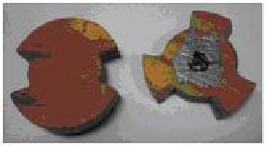Geology Reference
In-Depth Information
Sirens selected for intermediate and long wind tunnel testing should be
pre-screened using short wind tunnel tests for torque and erosion since the latter
are fast and inexpensive. For example, the two and three-lobe metal sirens in
Figure 9.14 were first studied as wood models in the short tunnel as indicated in
Figure 9.16a. Similar comments apply to the miniaturized, two-part, self-
spinning siren shown in Figure 9.4d. The turbosiren in Figure 9.16b provides
still another example; here, plastic and metal models are shown side-by-side.
Sirens-in-series, which may be used to increase signal when both operate at the
same frequency, or to increase data rate when each operates at distinctly
different frequencies, and sirens with “swept” lobes, which alter the harmonic
content of the main signal, are shown in Figure 9.16c. It is interesting to note
that siren signals sound like Harley-Davidson motorcycle engines in the room
during testing. This is especially interesting because, in long wave acoustics,
very little of the acoustic energy actually escapes the open end. Thus we are led
to conclude that the signal within the tunnel is much greater. The signal in the
corresponding mud flow would be approximately one thousand times more,
since the ratio of mud to air density takes that value.
Figure 9.16a.
Wood prototypes used for torque and erosion testing.
Figure 9.16b.
Wind tunnel forerunner to turbosiren (U.S. Patent 5,831,177).
Figure 9.16c.
Sirens in series (left) and “swept” rotors (right, middle).



Search WWH ::

Custom Search